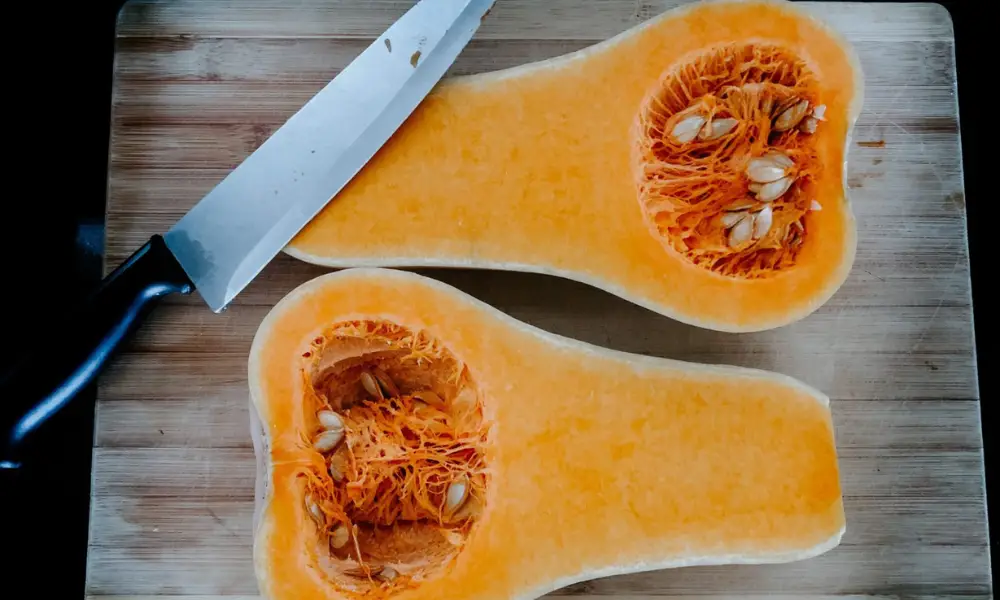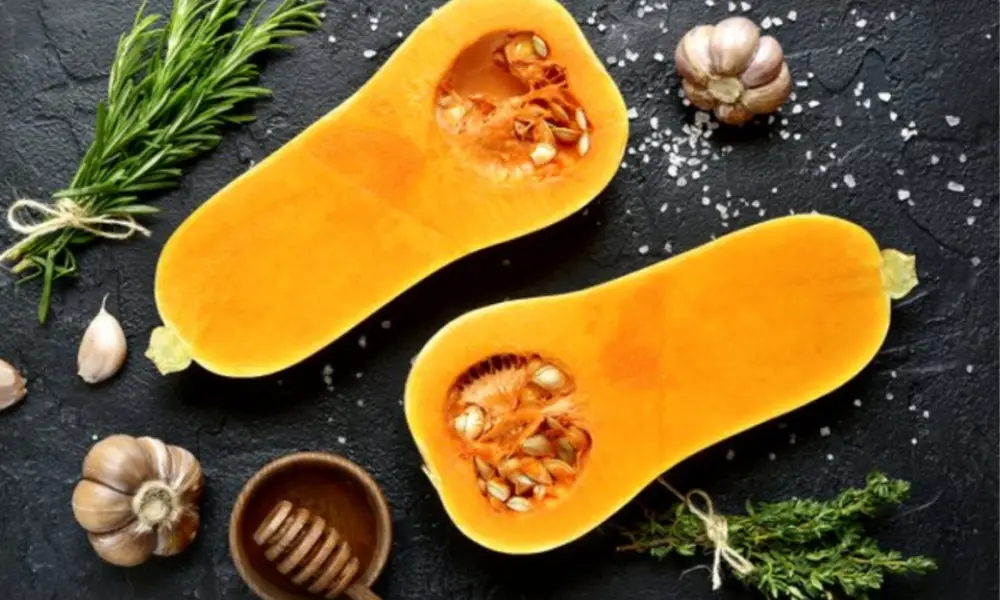If you’re wondering how to store butternut squash, you’ve come to the right place. Ripe or unripe, butternut squash is a great addition to any fall or winter meal. Whether you’re storing it in the fridge or using it right away, these tips will help you keep your squash in the best possible condition.
Butternut squash will improve in flavor as it ages. This is because the enzymes in the squash continue to convert starches into sugars. The squash will also lose water slowly, allowing the flavors to concentrate. It takes about two months for butternuts to reach their optimal taste. Some people even recommend storing them for up to two months after harvesting.

What is Butternut Squash?
Winter squashes come in a variety of colors, from pale yellow to brilliant orange, including butternut squash (Cucurbita moschata). Butternut squash is sweet and nutty, and it grows on vines. It has a rough rind and a pulpy core that contains seeds that resemble pumpkin seeds. You can roast, salt, or eat the seeds as a snack. Butternut squash has a wide range of culinary applications and is a rich source of carbs, vitamin A, and vitamin C. Butternut squash, when roasted and puréed, is a typical ingredient in fall and winter meals such as soups, muffins, and pies.
How to Store Butternut Squash?
The average storage period for butternut squash is two to three months, however, certain varieties can last up to six months. Follow these food storage recommendations to achieve this long shelf life:
Keep fruits and butternut squash separate. Fruits that ripen quickly, such as apples and pears, release ethylene gas, which can hasten the decay of butternut squash. Any level of relative humidity can aggravate ethylene gas release, hastening the ripening process.
Store your squash in a cool, dim location. The ideal storage environment for butternut squash is a dark, dry location that is between fifty and fifty-five degrees Fahrenheit below room temperature. Root cellars free of moisture, heat, and sunshine are appropriate locations, and those with sufficient air circulation can also create the best conditions for storing items.
Make use of a disinfectant. Make a solution of one part liquid bleach to ten parts water to help ensure long-term storage. The solution should be combined, then gently applied to the butternut squash skin using a moist towel. By doing this, rotting-causing microbes will grow more slowly.
Look for decaying and imperfections. Once it has been preserved, inspect your squash once a week for any fresh blemishes or soft areas. If you spot these, you might be able to save the squash’s edible healthy sections for immediate use or you could have to compost the rotting produce.
How to Pick a Butternut Squash that will Last Long?
You must know how to harvest winter squash or choose healthy ones from the grocery store if you want to keep them for a longer period of time.
Examine the stem. Your butternut squash might not be as fresh or durable if the stems have been removed. Select squash that has a stem that is at least an inch long.
Feel the squash’s weight. The freshness of butternut squash can also be determined by its weight. It is not fully matured if it is too light. You should strive for something on the heavier side. Feel a couple to get an idea of the average weight.
Look at the skin. Squashes with imperfections, rotten sections, or softer areas should be avoided. Additionally, you should search for skins with matte, rather than waxy, exteriors. Try to scratch the surface with your fingernail; if it comes through readily with little pressure, the squash is too soft for use.
Search for darker hues. Butternut squash is not ripe if it is green, excessively pale, or has little to no color. Look for deeper, richer shades of orange and amber. Just make sure the squash isn’t squishy or marred. A pale spot or two are acceptable.
What are Butternut Squash’s Health Advantages?
Due to its nutrients, incorporating butternut squash into your food plan may have some positive effects on your health.
Could Aid in Preventing Vision Loss
The body needs vitamin A to sustain the good vision. Butternut squash contains beta carotene, a type of vitamin A that is particularly important for eye health. Studies have shown that eating foods or supplements containing beta-carotene can help prevent age-related macular degeneration, a kind of vision loss that becomes more frequent as people age.
In addition, butternut squash has a lot of vitamin C, a tiny bit of vitamin E, and a tiny bit of zinc. A higher-than-average intake of vitamins C and E, beta-carotene, and zinc was connected to a 35% decrease in age-related macular degeneration.
May Lower Some Cancer Risk
Vitamin A, which is present in butternut squash, may aid in the prevention of several cancers. The proliferation and differentiation of cells depend on the vitamin. The relationship between beta carotene and a lower risk of lung and prostate cancer has been studied in some detail. For instance, studies on the connection between beta-carotene and lung cancer in smokers have produced mixed results.
Furthermore, a decreased incidence of prostate cancer has been associated with higher vitamin A intake. The relationship between vitamin A and the risk of developing cancer is still unclear, and an excess of vitamin A may even be hazardous.
May Lower the Risk of Mumps
Although measles is no longer common in the US, it is still a major cause of death in other developing nations. Serious measles increases the chance of a vitamin A deficiency. Eating meals high in vitamin A or taking a vitamin A supplement helps prevent vitamin A deficiency.
Reference: Nutritional composition and storage of butternut squash
What are the Negative Effects of Consuming Butternut Squash?
Overconsumption of preformed vitamin A, which is tolerated up to 3,000mcg per day, has been associated with poor outcomes. Preformed vitamin A, which is mostly found in meat and dairy products, has, however, been associated with adverse outcomes.
There are no known negative effects of the carotenoids beta-carotene and provitamin A found in plant-based diets like butternut squash. The only negative effect of exceedingly large intakes of plant-based vitamin A is carotenoderma, a benign condition in which the skin turns yellow-orange (excess beta-carotene). By staying away from products that are high in beta carotene, the condition can be reversed.
How to Prepare Butternut Squash?
Contrary to appearances, butternut squash is considerably simpler to peel, cut, and roast. These detailed instructions will show you how to prepare butternut squash.
Butternut Squash Peeling Instructions
The butternut squash should, first of all, have its skin removed. Why? Because using a vegetable peeler to peel butternut squash is much simpler than trying to peel it when it is still hot in the oven.
A straightforward vegetable peeler or knife would work for this. We advise using a vegetable peeler out of caution.
We’ve also learned that it’s rather easy to establish a technique for peeling around the squash and removing the right amount of butternut squash skin without wasting any of the delicious squash.
Butternut squash peeling techniques vary depending on the squash. For safety, we prefer to grab one end and move it away from our bodies. Peel the squash completely, till there is no more talent left.
Cut Butternut Squash Properly
The most difficult part of prepping butternut squash is cutting it in half. For this, you’ll need a razor-sharp knife and some elbow grease, so don’t be afraid to go all out.
Once it’s been cut in half, you may use a spoon to extract all of the seeds from the interior (longways, so the sides mirror each other). The seeds resemble and feel like pumpkin seeds. You can roast them for a delightful snack or discard them.
From here, cut the butternut squash into cubes.
One thing to consider while chopping up your butternut squash is the size of your cubes. They can be divided into any number of equal-sized pieces, and this will ensure that they cook evenly.
Using a Butternut Squash Roaster
Immediately after the butternut squash has been cut into cubes, drizzle it with olive oil (or any other oil of your choice) and season it with salt and pepper.
As a general rule, depending on what you’re preparing and the flavor you desire, start with salt and pepper and work your way up from there.
Butternut Squash Roast
The last step in cooking a butternut squash is roasting it. Our preferred temperature for cooking squash is a little higher—around 400 degrees Fahrenheit.
Set the oven’s temperature to 400 degrees.
Roast the food in the pan for 25–30 minutes in the oven.
To ensure that everything bakes uniformly and that the edges of the roasted butternut squash are golden brown and crispy, toss the butternut squash cubes halfway through the baking period.
You can tell when your squash is finished when it is soft and easily pierced with a fork. After removing them from the oven, allow them to cool for five minutes before serving.
Conclusion
When buying butternut squash, you should first look at its appearance and make sure it is ripe. Look for a firm rind and a full interior. You can also cut a section of the squash to check for any soft spots. You should also remove the stringy seeds if they are visible, as they are a sign of dehydration. If you notice any mold or organic growth on the squash, it is probably bad.
For a month, keep your squash in a cold, dark place like a pantry. Squash that hasn’t been cooked shouldn’t be kept in the fridge. Butternut squash should be kept in the refrigerator for 5 to 7 days after it has been peeled or otherwise prepared. After being peeled, butternut squash can be frozen. Slice or cube the raw squash, then seal it in airtight freezer bags and freeze for up to a year. In addition, cooked squash can be frozen. Although the flesh can be eaten raw, boiling it softens it and makes it easier to chew and digest.

